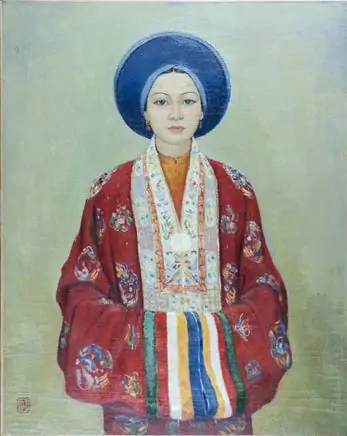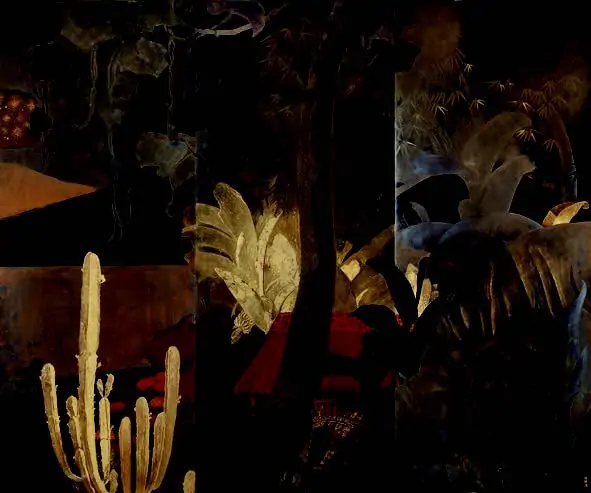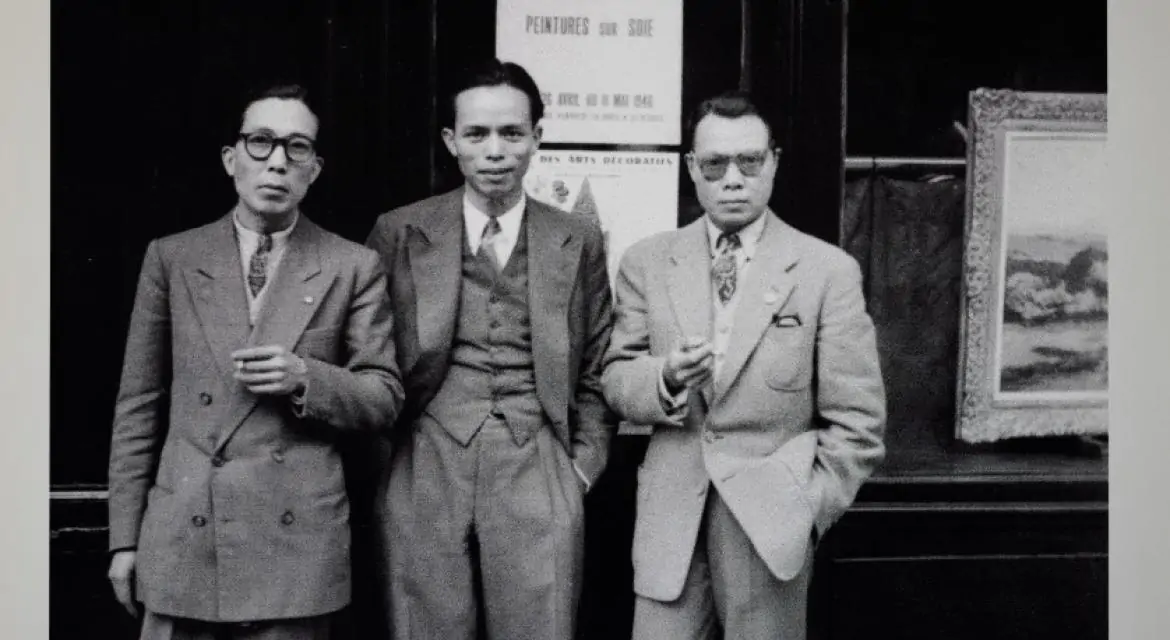Lê Phô, Mai-Thu, Vu Cao Dam Pioneers of modern Vietnamese art in France
11th October, 2024 – 9th March, 2025
Cernuschi Museum
7 avenue Vélasquez
75008 Paris
This autumn the Musée Cernuschi is staging the first major retrospective in France of three pioneers of modern Vietnamese art: Lê Phô (1907–2001), Mai-Thu (1906–1980) and Vu Cao Dam (1908-2000). Comprising 150 works by the three artists, the exhibition traces their progress from their studies at the Hanoi School of Fine Arts through their long careers in France from 1937 onwards.
This event coincides with the centenary of the Hanoi School of Fine Arts, where for the first time Western art and Vietnamese traditions were brought together in intense student-teacher exchanges that gave rise to a new, distinctively Indo-Chinese style.

Designed in close collaboration with the artists’ families, who have opened up their archives, the exhibition sets the intrepid careers of three friends who loved their homeland as much as France, against the backdrop of the political changes and relations between the two countries throughout the 20th century. Vintage photographs, drawings from their formative years and preparatory sketches are displayed alongside works on silk, oils on canvas, lacquered screens and sculptures in plaster and bronze. The association of techniques and materials drawn from Western and Asian traditions is emblematic of their work, which has found increasing recognition on the art market over the last thirty years
A unique opportunity: 150 works from 25 different collections
This exhibition – the first devoted to three representatives of the development of Vietnamese art in the 20th century – brings together 150 works from a variety of sources, including public and private lenders, the artists’ families, close friends (in the case of the oldest works) and everyday art lovers.
This is a unique opportunity to retrace the stylistic evolution of Lê Phô, Mai-Thu and Vu Cao Dam from the beginning to the end of their careers. Among the public lenders, the House of Southeast Asian Students at the Cité Internationale Universitaire in Paris is lending for the first time a large oil on canvas by Lê Phô dating from 1929 (210 x 450 m), the first commission he received while still a student. The Musée du Quai Branly – Jacques Chirac is lending a fine group of sculptures by Vu Cao Dam, and paintings by the three artists are being drawn from the collection of the Centre National des Arts Plastiques. Other lenders include France’s Mobilier National and the Ministry of Justice.

Private collection © Comité Mai-Thu, ADAGP,
Paris, [2024]
A CHRONOLOGICAL JOURNEY IN THREE PARTS
From art school in Hanoi to Paris in the 1930s Paris
Art education and the colonial context (1925–1931)
In the late 19th century France imposed protectorate status on Indochina. The colonial administration gradually created educational institutions including the Hanoi School of Fine Arts, a venture backed by Vietnamese intellectuals and artists of the time.
The movement was initiated by Nguyên Van Tho, known as Nam Son. Deploring the lack of a tertiary-level art school, this young, self-taught artist convinced French painter Victor Tardieu of the benefits of training Vietnamese artists in Western techniques. In 1925, the Indochina School of Fine Arts opened in Hanoi, under the direction of Victor Tardieu. The codes of European art and the concept of the artist in the Western sense of the term, were absorbed by the students, while the East Asian cultural heritage was made a core part of a planned artistic revival in Vietnam. These exchanges contributed to the birth of modern Vietnamese art.
World Fairs: official support (1931–1939)
Victor Tardieu, director of the Hanoi School of Fine Arts and an unflagging supporter of his Vietnamese students, knew that recognition for their work hinged on finding a wide audience. The colonial and universal exhibitions organised throughout Europe in the 1930s brought both respect for the new Indochinese school, which received rave reviews in the press, and a means for young artists to find buyers. In a context of colonial propaganda this support from the French state was a way of asserting the excellence of France’s educational policy, but its impact dwindled in the face of the rising German threat in Europe.
An audio terminal invites visitors to listen to documentary material elaborating on the links between Victor Tardieu and his students. The first extract, “Letter from Hanoi”, features the voice of Victor’s son Jean reflecting on a contemplative, poetic walk through the Tonkin countryside with his painter friend Lê Phô. There follows a newsy letter from Mai-Thu, then a drawing teacher in Hue, to his own teacher, Victor Tardieu. And in June 1937, Nam Son, a friend of Victor Tardieu, describes the dedication of the Art School director in a letter of condolence to his son Jean.

Tonkin Landscape
Hanoi, 1932 – 1934
Three-panel lacquered wood folding screen
Lam family collection
Adagp, Paris, [2024] / photo Sotheby’s
From the charms of artistic Paris to the tumult of war
Among Vietnam’s pioneering artists, Lê Phô, Mai-Thu and Vu Cao Dam stand out for having chosen to pursue their careers in France. Their period of study at the Hanoi School of Fine Arts triggered a shared urge to experience the artistic effervescence of Paris. Lê Phô was the first to make the trip, to supervise the layout of the Indochinese section of the Colonial Exhibition in 1931; he then returned in 1937 for the Universal Exhibition. Vu Cao Dam arrived in the French capital in December 1931 on a scholarship and Mai-Thu joined them in the summer of 1937. The adventure was prolonged by choice, but also by circumstances, as war raged successively on both sides of the continent, from 1939 to 1975: thirty-six years that made any return hazardous.
The Occupation: Mâcon and Nice (1940–1943)
In July 1940, Lê Phô and Mai-Thu were demobilised. Lê Phô went to Nice, while Mai-Thu stayed in Mâcon, where he had been posted during the 1939–1940 war. The Mâcon bourgeoisie recognised Mai-Thu’s talent: he received commissions for portraits on silk and for a fresco in a chapel in the church of Saint-Pierre – commissions that were very welcome during this difficult time. Late in 1943 Lê Phô and Mai-Thu returned to Paris where they once again joined forces with Vu Cao Dam.
1946: Ho Chi Minh and the Fontainebleau Conference
In the summer of 1946 Ho Chi Minh travelled to Paris for the Fontainebleau Conference. Vietnamese independence movements had taken advantage of the weakening of France during the Second World War and the Democratic Republic of Vietnam had been proclaimed on 2 September 1945. As its president, Ho Chi Minh now had to negotiate the terms of independence and he set out to convince French public opinion of the legitimacy of his demands. It was in this context that he met members of France’s Vietnamese community, including Lê Phô, Mai-Thu and Vu Cao Dam. Vu Cao Dam was authorised to sculpt a bust of the president, while Mai-Thu made a film about Ho Chi Minh’s stay in France.

© Adagp, Paris, [2024]
The French period
Evolution of the three styles Lê Phô and Mai-Thu joined Vu Cao Dam in Paris in 1937. No longer earning their salaries as drawing teachers, they had to make a living from their art. Creatively driven by their esprit de corps, they developed a common style, painting exclusively on silk and depicting an idealised Vietnam. Mai-Thu remained faithful to this style for the rest of his life, while varying his subjects. Lê Phô and Vu Cao Dam experimented with other modes of expression, notably a return to oil painting in the 1950s. Lê Phô’s late period was marked by a colourful post-Impressionist style in which the effects of light were the only real subject. Vu Cao Dam’s admiration for Chagall, whose neighbour he was in Saint-Paul-de-Vence, shone through in his late period.
The catalogue
Over the last thirty years Lê Phô, Mai-Thu and Vu Cao Dam have found increasing recognition on the art market, but there has never been a publication devoted to those singular careers ranging from Indochina to France. The exhibition catalogue is designed as a reference work, highlighting the major periods in the lives and careers of each of the three artists. Their personal choices are considered in the light of the mark history has left on their careers. The colonial context, Vietnam’s national emancipation, and the period of the three successive wars between 1939 and 1975 are discussed at length, giving the reader a better understanding of the development of their style and their favourite themes.
Editor: Anne Fort
Contributors: Nadine André-Pallois – Anne Fort – Marie Garambois – Sarah
Ligner – Martina Thucnhi Nguyen – Phuong Ngoc Nguyen – Phoebe Scott
Published by Éditions Paris Musées: 21 x 30 cm, paperback, 208 pages,
200 illustrations. €35
Lê Phô, Mai-Thu, Vu Cao Dam Pioneers of modern Vietnamese art in France
11th October, 2024 – 9th March, 2025 Cernuschi Museum
©2024 Musée Cernuschi





